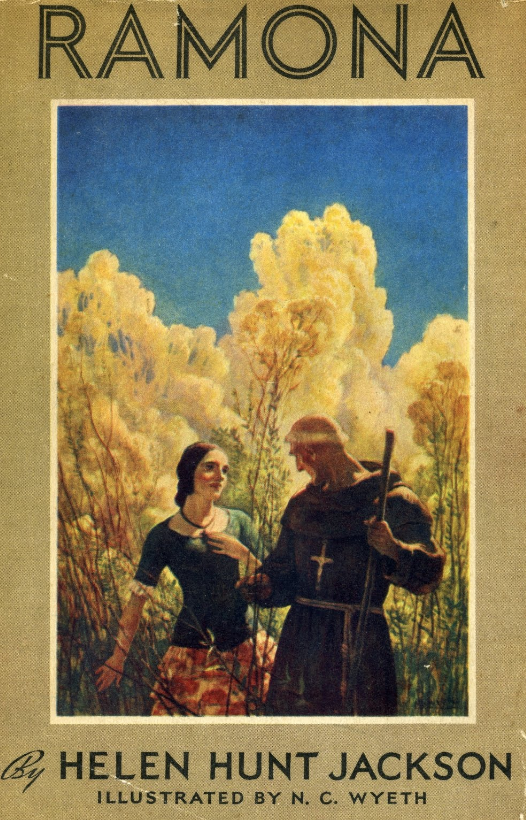This is part of Diane’s Literature Course I Series
The first time I read Ramona by Helen Hunt Jackson (not Beverly Cleary), was with my beloved book group in Colorado Springs. The person who chose the book for group perusal chose it partly because of Jackson’s Colorado Springs ties. As I’ve read more about her, I realize those ties are rather tenuous. Her second husband was a Colorado Springs founder, but the couple seem to have spent more time apart pursuing their own projects than living together in his mansion.

By the time Jackson was 35, she had endured the deaths of her husband and two sons. She was 45 when she married for the second time. Comments from people who knew her as a child indicate that she was born with an independent spirit. In 1879, she heard a lecture on the U.S. government’s treatment of an Indian tribe in Nebraska, which awakened an activist spirit in her as well. Not long after this, she wrote to a friend, “I have become what I have said a thousand times was the most odious thing in life, ‘a woman with a hobby.’ But I cannot help it.’” Jackson plunged into a period of meticulous research into the Government’s record in Indian relations. In 1881 she published A Century of Dishonor, a chronicle of the federal and states’ treaty violations and Indian Agency corruption.
While in California for the sake of her health, she began to study the history of the Spanish missions and the Mission Indians. Outraged by what she learned, she began writing Ramona, stating her goal in a letter: “If I could write a story that would do for the Indian one-hundredth part what Uncle Tom’s Cabin did for the Negro, I would be thankful the rest of my life.” Knowing that people are more inclined to read a novel than an exposé, she wrote a story of forbidden love and the resulting tragedy.
Fortunately for Jackson, her romance was a best-seller. Unfortunately for her, though her book generated some interest in the Indian plight, it did not have the impact of Uncle Tom’s Cabin. It did, however, spark a tourist industry. To this day, you may visit Ramona, California, take the “Ramona” tour, and see the Ramona Pageant. The story was the subject of a silent movie in 1910, and has been adapted for the screen several times since.
My girls and I discussed possible reasons for the failure of Jackson’s intent, which they explained in their essays. See the excerpts below with at least one spoiler.

“In Uncle Tom’s Cabin, Stowe developed her characters very well. She made them come alive by letting them show their qualities in their actions and speech. Instead of giving them fairy tale lives, she gave them sorrows, but also joys. Stowe gave her characters thoughts and feelings, making them very thorough and well-developed. However, in Ramona, Jackson does not develop her characters very well. She wrote in such a way that she told the reader everything. If Ramona was sweet, Jackson told the reader that, instead of writing in such a way that Ramona showed that quality with her thoughts or actions. She gave her characters qualities, but not in quite the same way as Stowe. In conclusion, Jackson’s characters are rather shallow.
“In Harriet Beecher Stowe’s book, in the first page, she began developing her conflict. The second page, the conflict is developed and her characters’ lives are about to be completely changed from how they used to be. Though this may sound far-fetched, that is how Stowe writes. She gets into the action right away. Because action is often exciting, her type of writing is very appealing to her reader. This is much different than Jackson. Jackson took a very long time to develop anything. In fact, her main character is not introduced until chapter three! The reader does not know what the conflict is for a very long time. Jackson’s type of writing is not unlike a soap opera. All her characters are very dramatic, and tend to overdo the tears, gushing, etc. For many readers, that is not exactly appealing.” L.J.W. (13)
“Ramona began happily. Ramona, though she was an orphan and rather unloved, had a good life, and she was happy. The story began nonchalantly, and the character of Ramona was not even introduced until chapter three. On the other hand, Uncle Tom’s Cabin began almost immediately with heartbreak. From the first chapter, the characters were in trouble.
“The Indian problem was an aside to the love story between Ramona and Alessandro. Rather than focusing on the Indian problem, and adding a bit of romance to lighten the story, Jackson wrote a romance with a few tragic problems, including the plight of the Indians. Stowe wrote about the slavery problem, and added the characters to make the story real.” L.W. (15)
“The main theme in Ramona is a forbidden love story between Ramona and the Indian Alessandro. They eventually marry and run away. Unfortunately, Alessandro is shot and killed, and Ramona finds love again with Felipe. Jackson does little to focus on the Indian hardships. The Indians and their plight became overshadowed by this love theme.
“However, Stowe stabs you in the heart by separating families with a dog drowning in the beginning of Uncle Tom’s Cabin. Stowe focuses on the pain and suffering of the Southern black slaves. Stowe creates an unforgettable image of inhuman treatment of one man to another. The only love story in Uncle Tom’s Cabin was Tom’s love for God.” B.B (16)